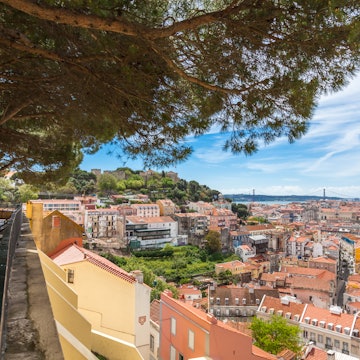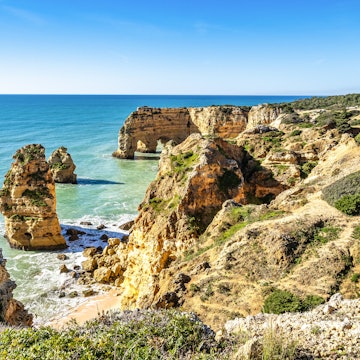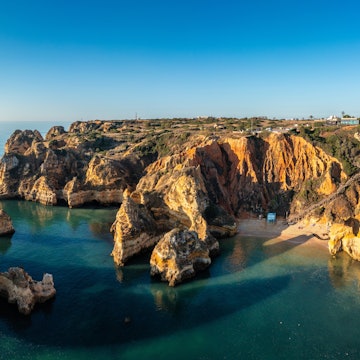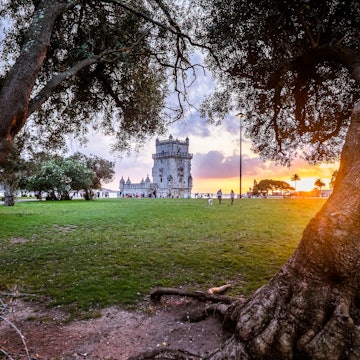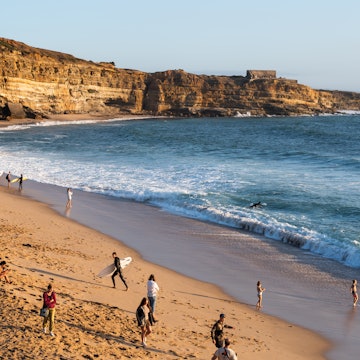

Surfers on the Vicentina Coast. Ana Couto/Shutterstock
The southernmost corner of Portugal , the Algarve, reigns as one of Europe's great surfing playgrounds. Unfolding in a zigzag of wide bays and blustery headlands, the stretch of Algarve shoreline known as the Vicentina Coast feels the full force of the Atlantic and has the waves to show for it. Along the southern shore, the wintertime swells work best once the summer holidaymakers have departed. This area, known as the Albufeira Strip, provides spinning barrels and shapely beach breaks for learners and pros alike. Regardless of which string of surf towns you visit, the Algarve has breaks for all levels, and the coastlines facing to the south and west get going at different times of the year. Let this guide set you off on a surfing adventure you wonʻt soon forget.
A surfer's playground
Portugal isn't hailed as a surf capital for nothing. There are surfable waves here all year round; the real question is what sort of waves you are after?
The Algarve is unique in that it strings along the south of the country but also has exposure to the open Atlantic on its western side. During the winter, strong swells come in from the North Atlantic. They bend around the Sagres headland, bringing makeable waves to south-facing beaches such as Zavial and Faro; simultaneously, they bring huge overheads to west-facing beaches.
From spring to fall, good exposure to the open ocean means there's usually action on the west coast, all the way from Tonel to Praia da Amoreira.


Sagres
The surf capital of the Algarve
Sagres has established itself as the epicenter of surfing in the Algarve. Two coastlines converge here – the wilder west coast and the more protected south. This means versatility and consistency in the breaks, with exposed areas that perform well in the summer months and enclosed bays that come into their own during the winter.
The swell magnet of Sagres is Tonel Beach, set below the cliffs in the shadow of the muscular Fortaleza, opening to face directly west into the Atlantic. A rock stack in the middle of the bay halves the line-up, but the strongest waves are always on its south side. Beginners tend to head to either Mareta or Martinhal beach, where the sets lose power deflecting around the headland before hitting the shore.
It's a toss-up between Natura and Wave Sensations when it comes to picking the top surf camp here. Whichever you go for, you can look forward to staying in a buzzy little beach town that's used to traveling surfers (to put it another way, localism is rarely an issue here).
Getting there: Sagres is right at the intersection of the N125, which runs east towards Lagos and Faro, and the N268, heading north to Lisbon. The quickest way in is to fly to Faro and make the 1.5-hour drive west to the point.
Arrifana Beach
A learner's paradise for summer surfers
Arrifana is hallowed ground in the learn-to-surf world. When the Atlantic swell slackens off a bit in the summer months, this beach becomes a hubbub of surf camps and surf schools. Why so? Well, the waves are pretty forgiving, break only over sand, and there's lots of whitewash (the white bubbly water left after a wave breaks) for first-timers to practice on.
As autumn and winter approach, Arrifana turns a bit more gnarly. The main beach break is prone to closing out and can be a real chore to battle. The saving grace of surfing Arrifana in winter is a high-quality right-hander for experts only, shaping up into occasional barrels on the north end of the bay by the harbor.
There are places to stay right on the cliffs above Arrifana, but nothing to beat stopping over in moody Aljezur. This small town is a 10-minute drive from the beach through the heather scrub of the Costa Vicentina reserve, unfolding in a straggle of stooped white cottages – many operating as Airbnbs – beneath a Moorish-era castle.
Getting there: A country road cuts across to Arrifana Beach from the N120, the main road that passes through Aljezur. The drive takes about 40 minutes from Sagres.


Carrapateira
Punchy swells under the cliffs
Carrapateira is the name for the village of sandy streets that sits on the hill just above Praia da Bordeira. Locals use the same name for the huge sandstone cliffs at the south end of the bay, which is where you should head to scope out this uber-consistent western Algarve surf spot.
There are two breaks. The first is the right-hander you'll see working just under the headland. It can handle waves of some size and skims across some disconcertingly shallow pockets of rocky reef, so it's best left to locals who know the area well. Running north, the main beach offers powerful peaks that are a dream for intermediate surfers, although there's a strong rip pulling northwards; expect to paddle a lot to maintain your position.
If you need gear or lessons, a surf rental kiosk – Carrapateira Surf School – operates on Praia da Bordeira, right on the sand.
Getting there: Drive up the N268 from Sagres and turn off onto the Bordeira beach road at Carrapateira town. There's parking about 500m (0.3 miles) from the breaks on the main beach road.
Zavial
South coast barrels treasured by locals
Zavial is all about the wedgy and hollow right that starts on the honey-tinged rocks at the western end of the beach. It's patrolled by a phalanx of local rippers when it's working, so respect and deference are key here if you want a shot at savoring this break. The reward is one of the Algarve's best waves and the potential to get pitted.
A fickle beast, the right at Zavial really needs heavy northwest winter swells to get working. During the summer, the beach mostly offers sets of knee-high babblers for learners. Low tide is best but, again, it's the resident crews that will be the main hazard to getting onto a wave; arriving really early will pay off.
Getting there: To reach Zavial by car, turn off the N125 south coast road at Raposeira and head south through Hortas do Tabual. There's parking adjacent to the restaurant by the beach.

Praia do Beliche
Surfing on the very edge of southern Portugal
An amphitheater of soaring cliffs surrounds Praia do Beliche, which puts on one of the first real shows of pure drama on the Atlantic-facing side of the Algarve. You can even see the rock-ribbed Cabo de São Vicente from here – it's the southwesternmost point of Portugal and mainland Europe.
For surfers, the draw is a bay that's a touch more protected than Tonel in nearby Sagres. When the Atlantic is frothing in midwinter, Praia do Beliche can manage some shapely left-right wedges that hold well as they bend around the rocks. Summer is less reliable, but it's worth heading this way even during a swell drought, because the beach flaunts its ochre-tinged sands and teal waters even when it's still.
Getting there: The only way in is a detour up the N268 road out of Sagres. The same road continues past the eroded Fortaleza do Beliche to Cabo de São Vicente.
Praia da Amoreira
Aljezur's best-kept secret for surfers
Praia da Amoreira marks the spot where the snaking Aljezur River meets the ocean. It's a fine location, hemmed in by the reed-sprouting wetlands of the Costa Vicentina reserve, with undulating dunes and pine forests rising and falling behind the sand.
The surf here tends to be overlooked by those who rush to nearby Arrifana. That means crowds are usually thin on the ground. Nevertheless, Amoreira is the base for local surf school, Surflife Atlantic Riders, and it garners respect for its inside beach break and outer reefs, which offer beefy left slabs for experienced surfers when the tide is low.
Flat days are fantastic at Praia da Amoreira, too. Time a visit for high tide and you can stand-up paddleboard and swim in the coastal lagoon that fills up along the Aljezur River (just beware of the rips). On the cliffs at the south end of the bay, Taberna do Gabriel II is the prime spot for a post-surf lunch and beer.
Getting there: A winding road leaves the north side of Aljezur town and goes all the way to Praia da Amoreira, a drive of just more than 10 minutes.


Praia do Castelejo
A reliable, all-level spot on the Atlantic
North of Sagres, Praia do Castelejo meets the open Atlantic in a perfectly swell-sucking northwest orientation, so the waves here tend to be working when other places in the Algarve are flatter than an Azorean flatbread. That's both good news and bad news: good for the summer months when you can surf overhead wedges, but bad for winter when Castelejo is often way too exposed for its own good.
The main wave at Castelejo is a right-hand point that hits a cluster of stones at the north end of the bay. There's also an inside section that's fairly good for intermediate improvers and even beginners during smaller swells.
Getting there: Come by car; make for the charming Algarvian surf town of Vila do Bispo and then drive up the M1265 through the hills straight to the beach.
Faro
The ideal first stop for new surfers
Navigate your way through the flamingo-stalked saltmarshes of the Ria Formosa Nature Park to reach Praia de Faro. This 14.5km (9-mile) strand is blessed with a series of shifting sandbanks that produce some of the most beginner-friendly waves in the Algarve.
The surf rarely gets too heavy on the barrier islands of the south coast because the waves from the Atlantic need to do a lot of work to push past the Sagres headland and keep their power. The result? Faro Beach gets punchy chest-high sets for much of the winter and smaller waves that are suited to longboarders in the warmer months.
When it comes to accommodations, stick to the area around the bridge linking Praia de Faro to Faro town to be in the midst of the action. There are shoreline B&Bs there, along with two highly-rated surf schools – AMAR Surfing Academia and Surf Club Faro.
Getting there: Faro is home to the main airport in the Algarve, and the surf beaches are less than 10 minutes by car from the arrival terminal, following the coastal causeway.
Where do locals surf in Portugal?
Portugal has a reputation of being one of the friendlier places to paddle out in Europe. International crowds have been coming here for years, so most local surfers are well used to tourists in the water, especially at popular beginner spots such as Arrifana and Sagres.
There are a few exceptions to this rule, however; certain breaks are closely guarded local stomping grounds. In the Algarve, Zavial and the cliff breaks of Carrapateira come to mind, so surf respectfully at these spots.
The same surf etiquette applies in Portugal as in any wave-rich destination around the globe. Always give priority to the surfer closest to the peak, never drop in on anyone, always remain in control of your board and treat everyone (locals and travelers alike) with respect.









